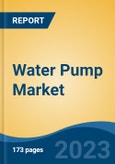Speak directly to the analyst to clarify any post sales queries you may have.
10% Free customizationThis report comes with 10% free customization, enabling you to add data that meets your specific business needs.
The global water pump market is experiencing steady growth, driven by increasing demand across various sectors, including agriculture, municipal water supply, industrial applications, and wastewater management. Rising urbanization, industrialization, and infrastructure development are key factors fueling the market expansion, particularly in emerging economies such as China, India, and Southeast Asian nations. Water scarcity concerns and government initiatives promoting efficient water usage further propel market demand, leading to technological advancements in pump designs for enhanced energy efficiency and sustainability.
Centrifugal and positive displacement pumps dominate the market, with centrifugal pumps widely used in water supply and wastewater treatment due to their high efficiency and reliability. Meanwhile, positive displacement pumps are preferred in industries requiring precise fluid handling, such as chemical processing and oil & gas. The growing need for energy-efficient pumps has prompted manufacturers to introduce smart pumps with variable frequency drives (VFDs) and IoT-enabled monitoring systems, reducing operational costs and improving efficiency.
Key Market Drivers
Rising Global Water Demand and Urbanization
The increasing global population and rapid urbanization are driving the need for reliable water supply systems, boosting demand for water pumps. According to the United Nations, the global population is projected to reach 9.7 billion by 2050, leading to a significant rise in freshwater consumption. Urban centers are expanding rapidly, with 68% of the world's population expected to live in cities by 2050, up from 56% in 2020. This urban growth necessitates extensive investments in water infrastructure, including municipal water supply, wastewater treatment, and flood control systems, all of which require advanced water pumps. Additionally, the World Bank estimates that global water demand is increasing by 1% annually, further intensifying the need for efficient water management solutions, thus fueling the water pump market.Key Market Challenges
Fluctuating Raw Material Prices and Supply Chain Disruptions
The water pump market is highly dependent on raw materials such as steel, cast iron, copper, aluminum, and rubber, which are subject to price volatility. Geopolitical tensions, trade restrictions, and supply chain disruptions significantly impact production costs. For instance, global steel prices surged by 50% in 2021 due to supply chain constraints and high demand from infrastructure projects.Additionally, the semiconductor shortage affected smart and variable frequency drive (VFD) pumps, delaying production timelines. The Russia-Ukraine conflict further strained raw material supply chains, particularly for metals and industrial components. Manufacturing companies are forced to pass on increased costs to consumers or absorb them, impacting profitability. Small and medium-sized enterprises (SMEs) struggle the most, as they lack the financial resilience of large corporations to manage price fluctuations.
Key Market Trends
Expansion of Wastewater Recycling and Treatment Projects
With increasing global concerns over water scarcity and pollution, wastewater recycling and treatment are gaining momentum, driving the demand for specialized water pumps. According to the United Nations, more than 40% of the world’s population faces water stress, making efficient wastewater management critical. Governments and municipalities are investing in advanced treatment plants to recycle and reuse water, thereby increasing the demand for centrifugal, submersible, and chemical dosing pumps. In China, wastewater treatment capacity is expected to expand by 50 million cubic meters per day by 2030, requiring large-scale pumping solutions. Similarly, the European Union has set a target to increase water reuse to 6 billion cubic meters annually by 2030, boosting the market for high-efficiency wastewater pumps.Key Market Players
- Grundfos Holding A/S
- Xylem Inc.
- Sulzer Ltd.
- KSB SE & Co. KGaA
- Ebara Corporation
- The Weir Group plc
- Flowserve Corporation
- Wilo SE
- ITT Inc.
- Kirloskar Brothers Limited
Report Scope:
In this report, the Global Water Pump Market has been segmented into the following categories, in addition to the industry trends which have also been detailed below:Water Pump Market, By Type:
- Centrifugal Pumps
- Positive Displacement Pumps
- Others
Water Pump Market, By Driving Force:
- Electric Driven
- Engine Driven
Water Pump Market, By Application:
- Oil & Gas
- Chemicals
- Power Generation
- Water/wastewater
- Others
Water Pump Market, By Region:
- North America
- United States
- Canada
- Mexico
- Europe
- Germany
- France
- United Kingdom
- Italy
- Spain
- South America
- Brazil
- Argentina
- Colombia
- Asia-Pacific
- China
- India
- Japan
- South Korea
- Australia
- Middle East & Africa
- Saudi Arabia
- UAE
- South Africa
Competitive Landscape
Company Profiles: Detailed analysis of the major companies present in the Global Water Pump Market.Available Customizations:
With the given market data, the publisher offers customizations according to a company's specific needs. The following customization options are available for the report.Company Information
- Detailed analysis and profiling of additional market players (up to five).
This product will be delivered within 1-3 business days.
Table of Contents
Companies Mentioned
- Grundfos Holding A/S
- Xylem Inc.
- Sulzer Ltd.
- KSB SE & Co. KGaA
- Ebara Corporation
- The Weir Group plc
- Flowserve Corporation
- Wilo SE
- ITT Inc.
- Kirloskar Brothers Limited
Table Information
| Report Attribute | Details |
|---|---|
| No. of Pages | 188 |
| Published | March 2025 |
| Forecast Period | 2024 - 2030 |
| Estimated Market Value ( USD | $ 62.07 Billion |
| Forecasted Market Value ( USD | $ 81.42 Billion |
| Compound Annual Growth Rate | 4.4% |
| Regions Covered | Global |
| No. of Companies Mentioned | 10 |









